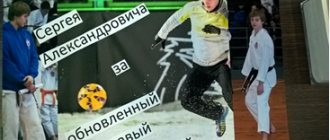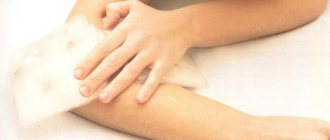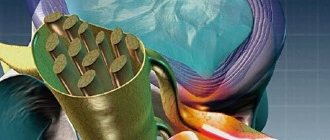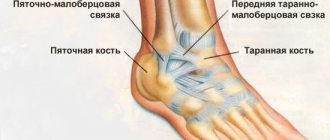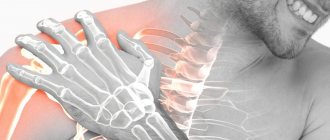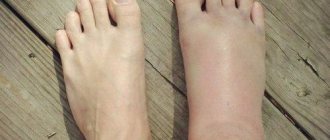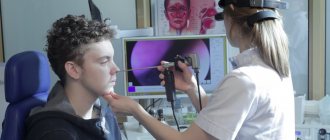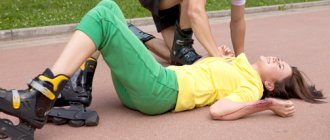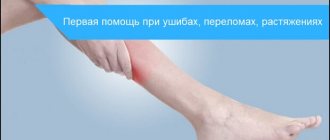The lower limbs are part of the musculoskeletal system of the human body, which daily accounts for a significant part of all physical activity, as well as exposure to dangerous traumatic factors. Contusions, bruises, dislocations, fractures, sprains, inflammation and tissue ruptures - anyone can face this, even those who are extremely far from sports or hard physical work.
Leg injuries usually do not pose a serious threat to human life, but can cause disability, loss of the ability to move independently and take care of oneself in everyday life.
Why are injuries dangerous?
Of course, for every person the ability to walk, run, move firmly and confidently on their own feet is very valuable and important. If a person loses mobility, he cannot live a full life, perform usual household chores, or work in positions that require certain physical activity.
Content:
- Why are injuries dangerous?
- Characteristics of lower extremity injuries
- What to do in case of injuries
- Types of dressings used for lower extremities
Injuries to the legs and pelvic area are one of the reasons that can contribute to a person’s disability and loss of the ability to walk, move, and run. Injuries of the lower extremities are conditions that occur due to mechanical action, when the integrity of muscles, ligaments, joints, bones, and skin is disrupted when parts of the articular apparatus change their location and cannot interact normally.
Lesions of the lower extremities are generally divided into two groups - closed and open. The former pose the greatest danger to humans, since they cannot be seen and assessed during visual inspection - the damage is located under the skin that has preserved its integrity. It can be tissue ruptures, fractures, dislocations, and less commonly, crushing of muscles and ligaments.
Open wounds and trauma mean that the skin at the site of injury is also torn, cut or crushed, and any internal damage can be seen. This principle of division is especially relevant for those who find themselves in a situation where it is necessary to provide first aid to victims during accidents, natural disasters, accidents, since even the absence of obvious external signs of damage is not a guarantee that everything is fine with the person.
What are the types of lower extremity injuries? All of them are differentiated by the nature of the disorder they cause in the body.
The most common:
- bruises and bruises;
- dislocations;
- fractures;
- ruptures and sprains;
- tissue crushing;
- meniscus tear.
Reasons for the development of the disease
The main causes of trophic ulcers are:
- extensive skin damage;
- burns;
- frostbite;
- chemical, radiation exposure;
- diabetes;
- phlebeurysm;
- thrombophlebitis;
- atherosclerosis;
- allergic reactions;
- bedsores;
- pathologies of the peripheral nervous system;
- tuberculosis, syphilis.
Also, a trophic ulcer can occur due to an infectious process in the body or metabolic disorders.
Characteristics of lower extremity injuries
A bruise, accompanied by swelling, bruising and pain, is considered the most gentle of all types of injuries to the lower extremities. It can occur after a fall or sharp blow. In this case, the integrity of the blood vessels in the skin is disrupted, a bruise appears, which changes its color over time. In addition, soft tissue bruises can accompany more dangerous injuries - fractures, ruptures.
Joint dislocation is a pathological condition in which parts of the joint, most often the articular head, leave their usual “location”, for example, the head extends beyond the acetabulum.
Such injuries occur due to the fact that a person makes a sudden and atypical movement that goes beyond the functional capabilities of the joint, as well as due to impacts and lifting heavy objects.
A bone fracture is the appearance of a crack or break in it, which may be accompanied by the distribution of bone fragments in the wound. Fractures can be closed or open - in the first case, the skin remains intact, and in the second, the skin is chopped or cut by protruding bone fragments or as a result of mechanical force. The person feels severe pain, the fracture site swells, and blood circulation is impaired. It becomes extremely difficult to move and step on the sore leg due to pain.
Tears and sprains of tissues, ligaments, and muscles occur due to sudden forced movements that exceed the ability of the joint to withstand loads. Athletes often encounter such injuries, but ordinary people are not immune from painful and dangerous injuries. It is especially facilitated by excessive overload, exercise in the gym without following the rules of exercise and safety precautions.
Tissue crushing occurs as a result of a strong blow - as a result, their normal structure and vitality, blood circulation and metabolic processes are disrupted. Such wounds are dangerous with a high probability of developing infection and inflammation; they take a long time and heal poorly.
The meniscus is a structural element of the articular apparatus, which serves to stabilize its component parts. The most common causes of a meniscus tear are sports activities. However, not only athletes can encounter it - older people with arthrosis also often experience rupture of this articular element. This condition is dangerous for humans, as it causes inflammation, fever, joint blockade, severe pain, and decreased mobility.
Purpose of dressings
Wound healing dressings for trophic ulcers must fulfill a number of requirements:
- provide a sterile environment, preventing infections from entering an open wound;
- stimulate the formation of granulation tissues;
- provide an environment favorable for healing processes;
- clean the surface of the wound from dead tissue and secretions;
- protect the ulcer from physical damage, friction, foreign particles, fibers;
- be hypoallergenic and vapor permeable;
- If necessary, it can be easily removed without causing pain to the patient.
You should not engage in amateur activities and try to treat trophic ulcers with folk remedies. This can lead to extremely serious consequences, including the development of gangrene and amputation of the limb.
What to do in case of injuries
Hip dislocations are mainly common in young and middle-aged people. In the elderly, in similar situations, a fracture of the femoral neck occurs. A dislocation can be determined by the unnatural position of the limb; in addition, if the dislocation is severe, it can be felt by palpation. The affected person is unable to carry out active movements, while at the same time passive motor activity is limited, and the joint reacts to it with springy resistance.
First aid for a hip dislocation has the following algorithm:
- the victim must be examined, his general condition and the presence of other injuries assessed;
- if a person is bleeding, there is no pulse and no respiratory activity, appropriate resuscitation measures must be taken;
- if a person is conscious, first of all, he must be carefully laid on his back on a flat, hard surface;
- To transport the patient to a medical facility, it is necessary to immobilize the damaged joint - for this purpose, splints and special bandages are applied;
- Reducing a dislocation on your own is strictly prohibited.
Femoral neck fractures are most common in women and older people. The victim experiences severe pain, which intensifies when trying to move the leg in the hip area. In this case, the leg seems to be turned outward. The hip joint area responds with pain upon palpation. Fractures of this type can have different varieties, depending on the location of the bone damage.
After the initial examination of the affected person, it is necessary to carry out transport immobilization of the fracture site by applying a bandage or splint.
Any changes in the position of the bone, traction, repositioning of fragments or removing them from the wound on your own are unacceptable.
Another type of fracture is pertrochanteric fracture of the femur, which occurs due to a fall on the side and a strong blow to the greater trochanter. The injured leg lies completely on the plane under the patient's outer surface, if he is lying on his back. In this case, splints (staircase or Dieterichs splint) are applied to the damaged area - this way the patient can be transported to a medical facility.
Fractures of the diaphysis and condyles of the femur cause violent eversion of the limb in unnatural positions associated with strong and sharp mechanical impact. Bruises of the knee joint occur as a result of falling on the knee, or a strong blow to it with heavy objects. The affected person experiences swelling, pain and difficulty walking. As first aid, the patient is given a fixing bandage and cold. Medical care for meniscus damage, including first aid, is directly related to the application of bandages to the knee joint - in this way it is possible to immobilize it.
In addition to the fact that bandages on the lower extremities are applied as a first aid measure to immobilize the site of injury, they can also be used as a treatment prescribed by a doctor after diagnosis and diagnosis. Also, dressings help avoid wound infection if they are made in compliance with sterile requirements. Dressing material soaked in medicinal ointments and preparations accelerates wound healing and reduces swelling.
Main symptoms
In the early stages, the defect is accompanied by swelling, itching, and thinning of the skin in the problem area. The following symptoms then develop:
- the skin becomes as thin as possible, becomes glossy, almost transparent;
- Stagnant lymph begins to appear on the surface of the dermis;
- chills and convulsions occur;
- the top layer of skin begins to peel off, resulting in an ulcer;
- the affected surface becomes infected, purulent discharge appears.
Trophic ulcers on the legs cause severe pain at the slightest touch. It is difficult to treat, so it is extremely important to start therapy in a timely manner. It is necessary to consult a doctor who will conduct a comprehensive diagnosis, select the correct treatment tactics and prescribe a number of rehabilitation measures.
How to apply a bandage correctly
There are several simple conditions for applying a bandage that must be observed if you do not want to aggravate the situation and introduce infection into the wound:
- Before the procedure, be sure to thoroughly wash your hands with soap and disinfect them with an antiseptic;
- Do not touch the affected area with your hands under any circumstances;
- use only sterile dressings sold in individual sealed packages;
- To further secure the patch and prevent it from moving, use special self-fixing bandages.
Following simple rules will help you achieve visible progress just a few days after applying the wound-healing bandage. It is important to strictly follow your doctor’s prescriptions and the instructions on the patch package.
Prevention measures
In the treatment of trophic ulcers on the legs, it is important to follow the doctor’s recommendations, which will help reduce local swelling and prevent recurrence of the skin defect. Patients are advised to use compression garments and elastic bandaging of the limb. In severe cases, it is necessary to strictly observe bed rest, use wheelchairs and follow recommendations aimed at maximizing unloading of the limb.
Remember: only a doctor can prescribe treatment if a trophic ulcer develops. You will not be able to choose the right treatment tactics on your own, which greatly increases the risk of developing serious complications.
Still have questions about the treatment of trophic ulcers?
Free consultation with AngioClinic specialists
Author
Salmina Daria Vladimirovna
Geneticist. Graduated from the Chelyabinsk State Medical Academy. She completed an internship at the Northwestern State Medical University named after I.I. Mechnikov.
